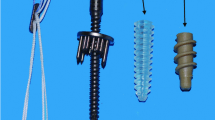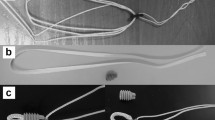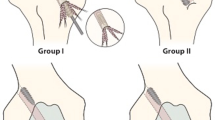Abstract
The weak point in an ACL reconstruction immediately after surgery is the tibial fixation of the graft. This factor will often limit the return to load-inducing activities. Many new hamstring-graft fixation devices have been introduced for cruciate ligament reconstruction, but there is little comparative data on their performance. This work tested the hypotheses that some of these devices will resist graft slippage under cyclic loads better than others, and that some will have higher ultimate strength than others. Five devices were tested: WasherLoc, Intrafix fastener; and RCI, Delta Tapered, and Bicortical interference screws. Cyclic loads representing normal walking activity (1000 cycles from 70 to 220 N) and ultimate strength tests were done, using calf tibiae (similar bone density to young human tibiae) and four-strand tendon grafts, with eight tests of each device for each of cyclic and ultimate tensile strength tests. A series of graft creep tests under cyclic loads was also done. The results showed that there was no significant difference in graft construct elongation under cyclic loads (range 0.7–1.3 mm) after allowing for 0.4 mm mean graft creep. The WasherLoc gave the highest ultimate strength (945 N, p <0.001, range 490–945 N). We concluded that all devices performed well under cyclic loads that represented normal walking activity, but the ultimate strengths differed. The performance under cyclic load was better than has been published for conventional interference screws. This evidence suggests that it may now be safe to mobilise younger patients less cautiously immediately after hamstring-graft ACL reconstruction.




Similar content being viewed by others
References
Amis AA (1988) The strength of artificial ligament anchorages—a comparative experimental study. J Bone Joint Surg Br 70:397–403
Beynnon BD, Amis AA (1998) In vitro testing protocols for the cruciate ligaments and ligament reconstructions. Knee Surg Sports Traumatol Arthrosc 6:S70–S76
Brown GA, Pena F, Grontvedt T, Labadie D, Engebretsen L (1996) Fixation strength of interference screw fixation in bovine, young human and elderly human cadaver knees: influence of insertion torque, tunnel-block gap, and interference. Knee Surg Sports Traumatol Arthrosc 3:238–244
Donahue TL, Gregersen C, Hull ML, Howell SM (2001) Comparison of viscoelastic, structural and material properties of double-looped anterior cruciate ligament grafts made from bovine digital extensor and human hamstring tendons. J Biomech Eng 123:162–169
Eejerhed L, Kartus J, Servert N, Kohler K, Karlsson J (2003) Patellar tendon or semitendinosus tendon autografts for anterior cruciate ligament reconstruction? A prospective randomised study with a two-year follow-up. Am J Sports Med 31:19–25
Fu FH, Bennett CH, Ma CB, Menetrey J, Lattermann C (2000) Current trends in anterior cruciate ligament reconstruction. Am J Sports Med 28:124–130
Giurea M, Zorilla P, Amis AA, Aichroth P (1999): Comparative pull-out and cyclic-loading strength tests of anchorage of hamstring tendon grafts in anterior cruciate ligament reconstruction. Am J Sports Med 27:1–5
Hamner DL, Brown CH, Steiner ME, Hecker AT, Hayes WC (1999) Hamstring tendon grafts for reconstruction of the anterior cruciate ligament: biomechanical evaluation of the use of multiple strands and tensioning techniques. J Bone Joint Surg Am 81:549–557
Harvey AR, Thomas NP, Amis AA (2003) The effect of screw length and position of fixation of four-stranded hamstring grafts for anterior cruciate ligament reconstruction. Knee 10:97–102
Jackson DW, Gasser SI (1994) Tibial tunnel placement in ACL reconstruction. Arthroscopy 10:124–131
Jackson DW, Schaefer RK (1990) Cyclops syndrome: loss of extension following intra-articular anterior cruciate ligament reconstruction. Arthroscopy 6:171–178
Jansson KA, Linko E, Sandelin J, Harilainen A (2003) A prospective randomised study of patellar versus hamstring tendon autografts for anterior cruciate ligament reconstruction. Am J Sports Med 31:12–18
Kurosaka M, Yoshiya S, Andrish JT (1987) A biomechanical comparison of different surgical techniques of graft fixation in anterior cruciate ligament reconstruction. Am J Sports Med 15:225–229
Morrison JB (1969) function of the knee joint in various activities. J Biomed Eng 4:573–580
Noyes FR, Barber-Westin SD (1996) Revision anterior cruciate ligament surgery: experiences from Cincinnati. Clin Orthop 325:116–129
Noyes FR, Butler DL, Grood ES, Zernicke RF, Hefzy MS (1984) Biomechanical analysis of human ligament grafts used in knee-ligament repairs and reconstructions. J Bone Joint Surg Am 66:344–352
Pinczewski LLA, Dechan DJ, Salmon LJ, Russell VJ, Clingeleffer A (2002) A five-year comparison of patellar tendon versus four-strand hamstring tendon autograft for arthroscopic reconstruction of the anterior cruciate ligament. Am J Sports Med 30:523–536
Shelbourne KD, Patel DV (1999) Treatment of limited motion after anterior cruciate ligament reconstruction. Knee Surg Sports Traumatol Arthrosc 7:85–92
Simonian PT, Harrison SD, Cooley VJ (1997) Assessment of morbidity of semitendinosus and gracilis tendon harvest for ACL reconstruction. Am J Knee Surg 10:54–59
Weiler A, Windhagen HJ, Raschke MJ, Laumeyer A, Hoffmann RFG (1998) Biodegradable interference screw fixation exhibits pull-out force and stiffness similar to titanium screws. Am J Sports Med 26:119–126
Woo SL-Y, Hollis JM, Adams DJ (1991) Tensile properties of the human femur–anterior cruciate ligament–tibia complex. The effect of specimen age and orientation. Am J Sports Med 19:217–225
Yasuda K, Tsujino J, Ohkoshi Y (1995) Graft site morbidity with autogenous semitendinosus and gracilis tendons. Am J Sports Med 23:706–714
Acknowledgements
We thank the fixation device manufacturers Arthrex, Arthrotek, Mitek, and Smith and Nephew for donating their products and lending their instruments for this study. The Instron machine was donated by the Arthritis Research Campaign, a UK-based charity.
Author information
Authors and Affiliations
Corresponding author
Rights and permissions
About this article
Cite this article
Coleridge, S.D., Amis, A.A. A comparison of five tibial-fixation systems in hamstring-graft anterior cruciate ligament reconstruction. Knee Surg Sports Traumatol Arthrosc 12, 391–397 (2004). https://doi.org/10.1007/s00167-003-0488-y
Received:
Accepted:
Published:
Issue Date:
DOI: https://doi.org/10.1007/s00167-003-0488-y




